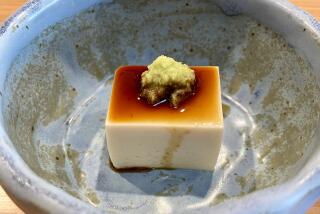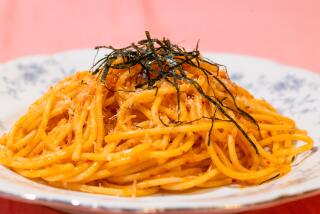So summery, so right: somen
“When I slurp
a bowl of somen noodles
it becomes a summer breeze.”
I am at the Granada Market, the neighborhood mom-and-pop grocery in West Los Angeles where I get my Japanese staples. The fish counter looks cheerful with roses and dahlias from the owner’s garden in empty milk bottles. A samurai saga is playing on satellite television. The volume is a tad too high, but I don’t complain because it’s part of the funky atmosphere here that has comforted me for more than 20 years.
The owner’s handprinted signs draw attention to premium Kobe beef, Meiji tofu and Jidori chicken. He has put aside a piece of toro for me, which I didn’t even order. But it’s wrapped and ready to go, so I am committed. There is a fresh-looking wasabi root next to the tuna. I ask him whether he will sell me just half. He does. My shopping cart fills up quickly and dangerously as I submit to my cravings and his sales pitches.
But it’s when I go down the narrow aisle of the noodle section that I really get excited because I see the food that for me defines summer eating -- somen.
All Japanese noodles, including somen, udon and soba, can be eaten hot or cold, but it is somen that stars during the hot summer months because Japanese consume them in enormous quantities to stay cool. It’s beloved to the point that in haiku, somen is a word that signifies summer.
Why are somen so extraordinarily cooling? Like angel hair pasta, somen is a very thin wheat noodle that takes only about two minutes to cook and about the same to chill. They are served in ice water with ice cubes added to give the noodles that extra chilling factor. This is what makes the experience of slurping somen so smooth and satisfying in the summertime.
Somen can be made by hand or machine. The hand-stretched noodles are called tenobe somen. They are a delicacy and are slightly more expensive than the standard machine-made noodles.
The classic way to eat somen is with a cold soy- and mirin-based dipping sauce, and an assortment of herbs and condiments Japanese call yakumi -- ginger, wasabi, chopped scallions, chives, myoga (a gingery flower bud) and minty shiso leaves.
Other choices can include roasted sesame seeds, chopped umeboshi (sour plum pickles) and spices such as shichimi and sansho peppers. You can also deviate from the classic recipe and try a fusion of Korean or Chinese fermented bean pastes or chile oil added to a soy-ginger-sesame-based dressing to give a nice heat.
Arrange everything in bowls around the chilled somen so each guest can garnish the noodles with whatever condiments appeal.
Pour the cold dipping sauce into the individual serving bowls. Use about one-third cup for each bowl. If you have beginning noodle slurpers, you can be the first person to demonstrate. Start by adding a pinch of sesame seeds, a dash of shichimi peppers, a dab of ginger or wasabi, and a teaspoon of sliced scallions to the dipping sauce.
Now pick up a bunch of noodles (enough for a mouthful or two) out of the ice water with your chopsticks and drop them into the sauce. At this time, you can put more garnishes on top, such as shiso, myoga, shredded chicken and cut nori seaweed. Do it quickly; you don’t want the sauce to overpower the noodles. Lift the bowl with one hand and use the chopsticks in the other to pick up a mouthful of the noodles and garnishes and give them a slurp. Slurping is not considered bad manners. It’s part of the noodle eating ritual. So go ahead and make that noise.
When you have finished the first round, go back and repeat what you just did.
Somen is typically eaten for lunch but can be served as an appetizer or side dish with grilled chicken, beef, shrimp or even sliced ham.
Slurping a bowl of cold somen is a good reason to shut off your air-conditioner and feel the heat of the summer and the cool of the noodles. As a girl, I survived the horrible muggy summers in Japan without air-conditioning in the house. With my brothers and sisters, we fought for the cool breeze of the single electric fan. Or went to the beach to swim.
But by far, the best solution for cooling down was eating cold somen. Grandmother would use an ice pick to break the big block of ice. We’d sit on the cool tatami mat and eat the somen that floated around the mini-iceberg in the bowl of ice water.
When you slurp your first bowl of somen, you will feel the summer breeze. You might even be inspired to scribble that haiku feeling or maybe you just want to keep slurping.
--
--
Iced somen noodles with chicken and vegetables with spicy ginger sesame sauce
Total time: 1 hour, 45 minutes, plus chilling time for the chicken
Servings: 6
Note: The degree of heat in the sauce is determined by the amount of tobanjan (hot Chinese miso paste) or la yu (hot Chinese chile oil) you use. You can also omit these seasonings and simply make a ginger sesame sauce. Alternatively, the soy-mirin dipping sauce used for the iced somen noodles with eggplant can also be served with this recipe as a second sauce, in which case you will need deeper serving bowls. Tobanjan and shiso leaves can be found at Japanese markets. Japanese tahini (sesame paste) is called atari goma or neri goma. You can find it at the Japanese market but tahini will work too. Stir the atari goma with a spoon before spooning out of the can as it will separate (the oil will rise to the surface).
Steamed chicken
2 small (or 1 large) chicken breasts, about 1 pound total
2 tablespoons sake
1 green onion, white part cut crosswise into 1/8 -inch slices (green and root tip discarded)
1 tablespoon peeled and thinly sliced ginger (from a 1-inch piece)
1 teaspoon sesame oil
1. Toss the chicken with the sake, onion and ginger in a shallow, heat-proof bowl large enough to hold the chicken.
2. Prepare a stove-top steamer and place the chicken, still in the bowl, on the rack in the steamer. Steam the chicken until the meat is cooked through; it will be firm and opaque and the juices will run clear, 20 to 25 minutes.
3. Remove from heat and cool the chicken in the bowl with the flavorings, then refrigerate the chicken, still in the bowl, until completely chilled. The chicken can be cooked up to 1 day ahead and refrigerated before shredding.
4. Shred the chicken into matchstick pieces about 3 inches long. Place the chicken in a medium bowl and toss with the sesame oil. Refrigerate the chicken, covered, until ready to use.
Spicy ginger sesame sauce
2 teaspoons fresh ginger juice (juiced from the grating of 1 small knob ginger)
2 tablespoons sesame paste (atari goma or neri goma) or tahini
2 teaspoons sugar
1 1/2 tablespoons sake
1 teaspoon toasted sesame oil
2 tablespoons rice vinegar
2 1/2 teaspoons soy sauce
2 tablespoons water
1 teaspoon tobanjan (Chinese hot miso paste) or 1/2 teaspoon la yu (Chinese chile oil) or to taste, optional
In a medium bowl, whisk together the ginger juice, sesame paste, sugar, sake, sesame oil, rice vinegar, soy sauce and water. Add the tobanjan or the la yu, a little at a time as desired (add the tobanjan one-eighth teaspoon at a time to taste, and the la yu a few drops at a time to taste), mixing and tasting until the desired heat is achieved. Strain if desired for a smoother sauce. Refrigerate, covered, until needed.
Noodles and assembly
2 eggs
2 teaspoons vegetable or canola oil, divided
3 bunches (300 grams) dried somen noodles
3 cups ice cubes
Steamed chicken
2 cucumbers (Japanese or Persian), peeled and cut into matchsticks 1/8 -inch wide and about 3 inches long
1 large carrot, peeled and cut into matchsticks 1/8 -inch wide and about 3 inches long
1 large green pepper, cut into matchsticks 1/8 -inch wide and about 3 inches long
1 bunch chives, chopped (about 1/4 cup) or 3 green onions, thinly sliced crosswise (white and green parts)
1 small bunch daikon (radish) sprouts, trimmed to remove roots, optional as garnish
6 to 8 shiso leaves, thinly sliced, optional as garnish
1 teaspoon toasted sesame seeds
Spicy ginger sesame sauce
1. Break the eggs into a small bowl and stir together.
2. Heat a medium nonstick frying pan over medium-high heat and add 1 teaspoon oil. Reduce the heat to low and gently add half of the egg to the pan, tilting the pan to form a large, thin crepe. Cook quickly and gently, careful not to burn (it should be completely yellow) but cooking until the egg is set and cooked through. Remove the crepe to a cutting board to cool slightly. Repeat with the remaining oil and egg.
3. When the first crepe is cool enough to handle, halve it to make two moons. Trim the edges to form each half into a rectangle about 3 inches wide. Cut each rectangle crosswise into matchsticks one-eighth inch wide. Set the sliced egg aside and repeat with the remaining crepe. Cover and refrigerate until needed. The egg can be prepared and refrigerated a few hours in advance.
4. Cook the somen: Bring a large pot of water to a boil and add the noodles, spreading them apart so they do not stick together while cooking. When the water returns to a boil, add half-cup tap water. Cook the noodles until they are al dente, about 3 minutes total cooking time. Immediately remove from heat.
5. Drain the noodles and cool them in a large bowl of water under running tap water. Gently swirl the noodles in the running water until the water runs clear. Drain the noodles again.
6. Place the noodles in a large bowl. Add the ice and enough water to mostly cover the noodles. Chill the noodles for at least 3 to 5 minutes before serving. The noodles will dry out rather quickly after they are removed from the water so try to keep the noodles in the water until just before serving.
7. When ready to serve, remove the noodles from the ice water and strain lightly. Make a bed of noodles on an oblong platter. Arrange the chicken, cucumber, carrot, green pepper and the egg matchsticks around the noodles. Garnish with chives, daikon radish sprouts, shiso leaves (one or all of them) and the roasted sesame seeds.
8. Let each person help themselves to the noodles. You can use small serving dishes. Toss the noodles, chicken and vegetables together and serve in individual dishes. Pass the ginger sesame sauce around. You only need two or three teaspoons to season each serving.
Each serving: 354 calories; 24 grams protein; 43 grams carbohydrates; 4 grams fiber; 8 grams fat; 2 grams saturated fat; 112 mg. cholesterol; 1,055 mg. sodium.
--
Iced somen noodles and fried eggplant with soy-mirin dipping sauce
Total time: 1 hour, plus cooling time for the sauce
Servings: 6
Note: This can be served for lunch or as an appetizer. The noodles take less than 3 minutes to cook, so have all the condiments ready to go before you cook the noodles. If you want more condiments, you can add shredded chicken and other julienned vegetables suggested in the recipe for iced somen with chicken and vegetables. Bonito flakes (dried tuna flakes), myoga root, shiso leaves, pickled plums, shichimi and sansho pepper, wasabi paste, somen noodles and kizami nori can be found at Japanese markets.
Soy-mirin dipping sauce
3 cups water
1 1/2 cups bonito flakes (they should be large flakes)
3 dried whole shiitake mushrooms, softened in warm water for 20 minutes (discard water after softening)
1/2 cup plus 2 tablespoons (5 ounces) mirin (sweet sake)
2/3 cup light color soy sauce (usukuchi-shoyu)
In a medium size pan, bring the water, bonito flakes, softened shiitake mushrooms, mirin and light color soy sauce to a boil over high heat. Reduce the heat and simmer gently for 3 minutes to infuse the flavors. Remove from heat, strain the sauce and discard the bonito flakes. Reserve the shiitake mushrooms; remove any tough stems and slice them thinly and use them as a condiment for the noodles. Let the dipping sauce come to room temperature, then refrigerate, covered until needed. This makes 3 1/2 cups sauce and will keep for 1 week, refrigerated.
Somen noodles and assembly
4 to 5 tablespoons toasted sesame oil
3 Japanese eggplant, cut crosswise into 1/2 -inch slices
2-3 myoga roots, cut into 1/8 -inch slices, optional
12 shiso leaves, cut into 1/8 -inch slices
4 scallions, white parts only cut crosswise into 1/8 -inch slices (discard green and root ends)
6 pickled plums (umeboshi), seeded and chopped to form a paste
1/4 cup peeled and grated ginger, from about a 4-inch root (reserve the juice to serve with the grated ginger)
1/4 cup toasted sesame seeds
Shichimi pepper (hot red dried chile)
Sansho pepper to taste
2 tablespoons wasabi paste
Sliced shiitakes reserved from the sauce
3 bunches of somen noodles (300 grams)
3 cups ice cubes
1 cup kizami nori (sliced pressed Japanese seaweed)
Prepared dipping sauce
1. In a medium, nonstick frying pan, heat a few tablespoons of the sesame oil and fry the eggplant until it is lightly browned on both sides and cooked through, about 5 minutes. Remove from heat and place on a serving dish.
2. Arrange the remaining condiments except the nori (myoga, shiso, scallions, plum paste, ginger, toasted sesame seeds, shichimi pepper, sansho pepper, wasabi paste and sliced shiitakes) on the same serving dish or in separate serving dishes.
3. Cook the somen: Bring a large pot of water to a boil and add the noodles, spreading them apart so they do not stick together while cooking. When the water returns to a boil, add half-cup tap water. Cook the noodles so they are al dente, about 3 minutes total cooking time. Immediately remove from heat.
4. Drain the noodles and cool them in a large bowl of water under running tap water. Gently swirl the noodles in the running water until the water runs clear. Drain the noodles again.
5. Place the noodles in a glass or pottery serving bowl. Add the ice and enough water to mostly cover the noodles. Chill for at least 3 to 5 minutes before serving.
6. Bring the chilled noodles to the table, along with the condiments. Arrange the nori with the rest of the condiments or in its own serving dish (arrange the nori last as it will wilt quickly around any sort of moisture). Pour one-third cup (or more as desired) dipping sauce into individual serving bowls for each of the guests.
7. Allow the guests to serve themselves, first by taking some of the noodles, then garnishing with condiments of their choice. Make sure guests garnish with the nori last so it stays dry until it reaches the mouth. When guests finish the first batch, go for seconds and thirds.
Each of 6 servings: 357 calories; 10 grams protein; 49 grams carbohydrates; 6 grams fiber; 14 grams fat; 2 grams saturated fat; 0 cholesterol; 1,554 mg. sodium.
More to Read
Eat your way across L.A.
Get our weekly Tasting Notes newsletter for reviews, news and more.
You may occasionally receive promotional content from the Los Angeles Times.










